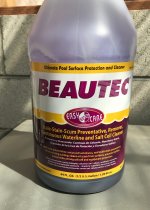Chemistry question for @JoyfulNoise :
I have noticed that my FC takes a ~1ppm jump the day after adding acid to my SWG pool. I generally test once a day and then add any needed chemicals. The Pebbletec pool is now about 6 months old and always covered except for the 30-60 minutes per day when it is in use, so the chlorine consumption is fairly low but is needing acid additions about twice a week. The additions are typically 32 oz of 14% HCl to the 6,100 gallon pool to drop the PH from 8.0 (and CSI of 0.3) back to 7.3 (CSI -0.3).
So the question is: Does the HCl directly add to the available free chlorine? Or is the efficiency of my SWG being effected by PH? On the latter one possibility that occurred to me is that perhaps a thin layer of calcium scale was forming on the SWG plates during the high side of the PH cycle (when the CSI is positive) and then is dissolved away when the CSI is negative again.
I have noticed that my FC takes a ~1ppm jump the day after adding acid to my SWG pool. I generally test once a day and then add any needed chemicals. The Pebbletec pool is now about 6 months old and always covered except for the 30-60 minutes per day when it is in use, so the chlorine consumption is fairly low but is needing acid additions about twice a week. The additions are typically 32 oz of 14% HCl to the 6,100 gallon pool to drop the PH from 8.0 (and CSI of 0.3) back to 7.3 (CSI -0.3).
So the question is: Does the HCl directly add to the available free chlorine? Or is the efficiency of my SWG being effected by PH? On the latter one possibility that occurred to me is that perhaps a thin layer of calcium scale was forming on the SWG plates during the high side of the PH cycle (when the CSI is positive) and then is dissolved away when the CSI is negative again.


